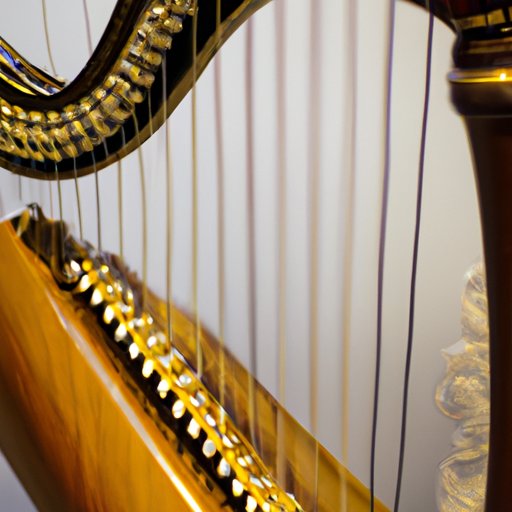Introduction
The harp is an ancient instrument with a rich history spanning thousands of years. As one of the oldest known stringed instruments, it has been used by many civilizations across the world and has evolved over time to become a versatile instrument with many different styles and techniques. Understanding when the harp was invented is important for appreciating the influence that this instrument has had on music and culture throughout the centuries.

Exploring the History of the Harp: Tracing the Invention of the Instrument
The earliest evidence of the harp dates back to Ancient Egypt, where it was depicted in hieroglyphs and murals dating from 3000 BCE. The instrument was likely introduced to Egypt from Mesopotamia, where similar stringed instruments were being used. From Egypt, the harp spread to other cultures like the Greeks, Romans, and Celts, who adopted the instrument and added their own unique touches to its design. By the Middle Ages, the harp had become a popular instrument in Europe, appearing in manuscripts and illustrations of the time period.
How Early Harps Shaped Music and Culture in Ancient Cultures
The harp has had a profound influence on music and culture in Ancient Egypt. In Egyptian mythology, the goddess Hathor was associated with the harp and was said to have invented it. The harp was also used in religious ceremonies and funerary rites and was believed to be a symbol of resurrection and rebirth. In Ancient Greece, the harp became a symbol of wealth and status, with the wealthy often commissioning harpists to play at their banquets and events.
In Celtic culture, the harp was seen as a symbol of sovereignty and was often used to accompany heroic tales and songs. According to legend, King David of Israel even used the harp to soothe King Saul’s troubled mind. The harp was also seen in Celtic mythology, with the god Dagda playing a magical harp capable of both summoning and banishing spirits.

A Look at the Evolution of the Harp from Antiquity to Modern Times
The harp has undergone many changes since its invention in Ancient Egypt. Over time, new techniques and styles of playing the harp emerged, and the instrument began to take on different shapes and sizes. In the 19th century, pedal harps were developed, allowing players to manipulate the pitch of the strings with pedals, making the instrument more versatile. Today, the harp has become one of the most popular stringed instruments, with many contemporary musicians incorporating it into their music.
The development of new technologies has also played a role in the evolution of the modern harp. Harps can now be made using lighter materials such as carbon fiber, which makes the instrument easier to transport and play. Digital harps are also available, which allow players to create complex sounds and effects without having to learn traditional harp techniques.
Examining the Craftsmanship and Design of Ancient Harps
Ancient harps were crafted out of a variety of materials, including wood, bone, and metal. The strings were usually made of gut or horsehair, and the tuning pegs were typically made of metal. Special techniques were used for crafting and tuning the harps, and many were decorated with symbols and images that held special meaning to the culture.

Discovering the Different Types of Harps Used Throughout History
Throughout history, different types of harps have been used in various cultures. In Ancient Egypt, harps were typically large and triangular in shape, with long necks and four or five strings. In Ancient Greece, the kithara was a popular type of harp, and in Medieval Europe, the arched harp was widely used. The pedal harp, which was developed in the 19th century, is still used today and is the most popular type of harp in modern music.
Conclusion
The harp is an ancient instrument with a long and fascinating history. Its invention can be traced back to Ancient Egypt, where it was used in religious ceremonies and funerary rites. Through its spread to other cultures, the harp has become a symbol of power and status, as well as a source of entertainment and comfort. The harp has evolved over time, taking on new designs and techniques, and is still used today in many different musical genres.
(Note: Is this article not meeting your expectations? Do you have knowledge or insights to share? Unlock new opportunities and expand your reach by joining our authors team. Click Registration to join us and share your expertise with our readers.)
